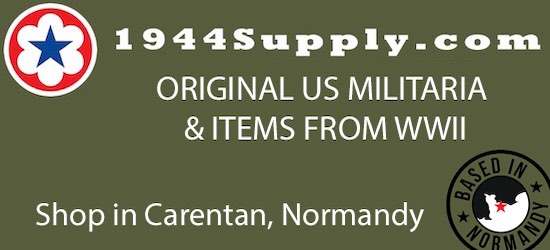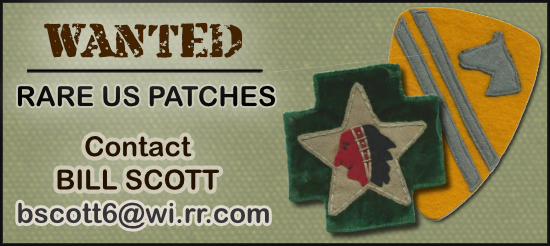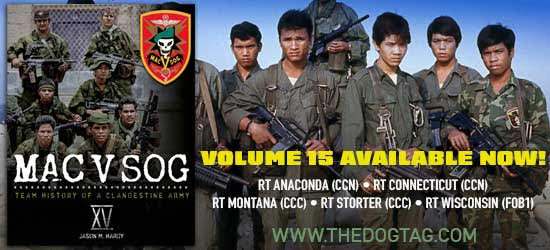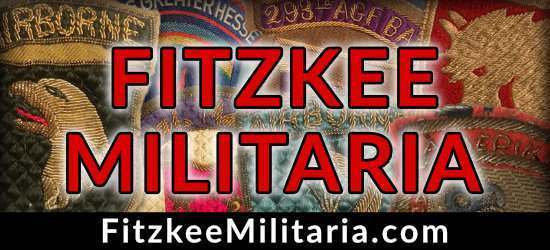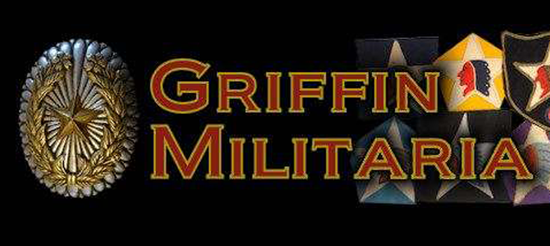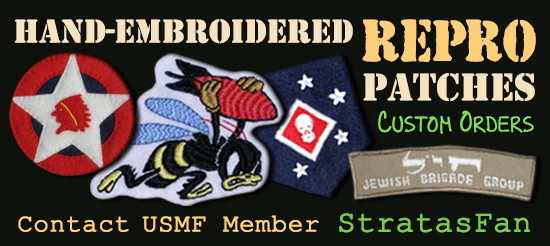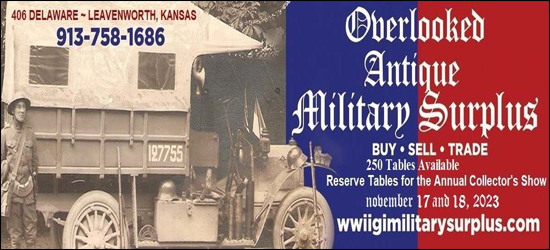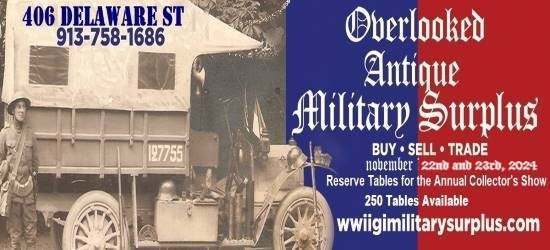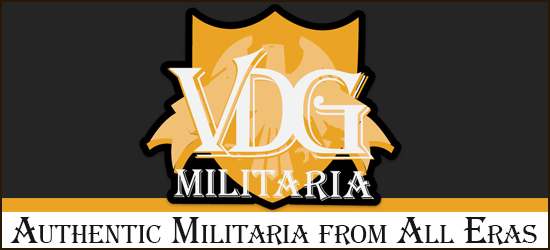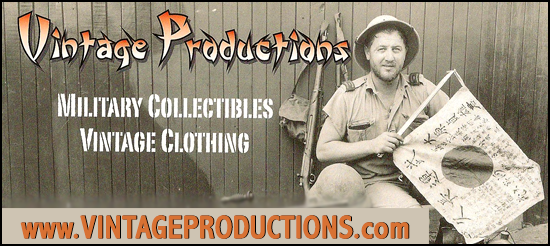-
Donate
Type donation amount in box below.
IMPORTANT! If you donate via PayPal using an e-mail address different than the one you are currently using on USMF and would like a 2024 Donor Icon added to your account, you MUST CONTACT vintageproductions or stratasfan and let them know what email address was used for the donation.
Thank you for supporting USMF.
Donate Sidebar by DevFuse -
Recent Posts
-

-

By cord_nipper · Posted
In 1993 at Fort Hood, I was issued two black felt MP Brassards with white lettering at CIF. I was issued one green brassard with black letters by my unit for field use. I private purchased my black letter brassard. -

By CMT04 · Posted
No providence besides the fact I 100 percent trust the person who sold it to me and that he got it from John Coy 35 years ago. I know John Coy knew his stuff but it’s very possible with the age of this that fake paint may not have been as numerous back then and it wasn’t as highly scrutinized. And no one is perfect. -

By DMD · Posted
Thanks, Randy. Can you estimate the time period for the patch? -

-

By atb · Posted
Units assigned directly to the 1FF wore that SSI even as they were OPCONed to other units. Many artillery units were assigned as "corps" artillery to 1FF. -

By Rhscott · Posted
1st FF was a Corps like command element of various Divisions and separate battalions each having its own SSI. Why would a unit adopt the 1st FF SSI in place of the one they had going into theater? -

-

By Alwayslookingfordqp · Posted
This post is a few days late but today in remembrance of the often overlooked Wickham Anchorage raid on June 30th 1943, 82 years ago, I would like to share this phenomenal set of raider patched greens. This set is named to the 5 campaign veteran BAR man Sgt. Frank “Andy” Anderson of 2nd Plt, Co “Q” 4th Raider Bn and Co “F” 2nd Bn 4th marines. Frank served in the bloody raid’s on Wickham Anchorage where his group was separated in a botched landing then almost a month later at Bairoko Harbor where they smashed against an impenetrable line of defensive positions. With the 4th marines he participated in Emirau, Guam and Okinawa where he was WIA and awarded a Navy Commendation Ribbon. Even though this uniform is named to Frank A Anderson it was originally gifted by another raider, Marvin D Butterfield to a collector friend of mine. Marvin could not recall when, where or how he acquired the uniform but he had kept it for himself for as long as he could remember. Mr Butterfield was a late raider joining the 1st Raider Bn shortly before they were disbanded, he went on to join Co “C” 1st Bn 4th marines and served at Emirau and Guam where he was WIA on the 26th of July. Considering the uniform was originally Anderson’s this post is going to focus on his service, particularly when he was a raider. I would highly suggest reading the portions on Wickham Anchorage and Bairoko Harbor . Pre war Frank was born on Feb 24th 1922 in Portland Oregon to a Swedish immigrant and Kansas native. After completing high school he chose to continue his education and attended college for bookkeeping and typing. While attending college Frank initially worked as a cook on a lake steamer for 2 years but in March of 1941 he changed his line of work. Instead of sailing and working on board ships he went to work building them when he joined the crew at the newly established Oregon Shipbuilding Corporation owned by the Kaiser Company. Here his job was to ream, rivet and seal the steel plating on the hulls of the new Liberty fleet. He would continue this work assembling ships for the war effort until he quit on the 1st of September 1942. Early war Frank enlisted on September 29th 1942 in Portland Oregon and instantly shipped to San Diego joining the 2nd recruit Bn. Once Frank completed boot camp, Jimmy Rosevelt the presidents son and the commander of the then forming 4th Raider Bn arrived at camp looking for volunteers. Explaining to the men that if they come with him their chances of getting injured were very high but their chances of getting a shot at a Japanese were very good he mustered over a hundred volunteers. Jimmy having been Col Carlsons XO for the 2nd Raider Bn knew exactly what he was looking for though. Soon enough after interviews and physical evaluations the volunteers were slimmed down to around 9 men and shipped out into the boondocks of the newly established Camp Joseph H Pendleton. Here their training drastically changed from what they were used to. The men focused heavily on stamina going on 20-30 mile hikes, hand to hand combat, fireteams, and specializing in all the weapons the battalion would deploy from rifles and BAR’s to Mortars and Anti tank guns, that way if a man fell beside them in battle that was a specialist they could pick up his weapon and use it effectively. The men were also indoctrinated on the 2nd raider Bn’s “Gung-Ho” philosophy, Officers led by Consensus as the men spoke freely of what they thought they should do and what was good and bad. All men were treated equally, ate together, slept together and trained together no matter the rank. Not a single person got special treatment, not even Jimmy Rosevelt. The Officers led by example from the front and everyone bonded with each other more akin to family rather than a team. Aside from their training their living commodities also changed preparing them for how they would be living when they were operating in the islands. The men slept in tents, had no electricity, mess hall or kitchen and the battalion was only afforded one cold water spicket for showering. During this time the men also left camp to participate in some highly specialized training pertaining to rubber boating. They learned to be highly proficient swimmers and how to maneuver rubber boats on the breakers and in the swells of the Pacific Ocean, a lesson that their XO Jimmy Rosevelt had learned the hard way. After becoming proficient with their rubber boats the men were detached in small groups and learned how to board, debark, and live on submarines in order to execute night time raids deep in enemy territory. Although they trained for these sort of actions the 4th Bn was sadly never deployed in any large scale from submarines. Into the Pacific Boarding the SS President Polk on the 9th of Feb 1943 the raiders set out for the pacific. Although being a luxury liner this was far from a luxury cruise. The conditions were cramped, the men needed to relieve themselves over the side of the ship, their food quickly spoiled and water was rationed to a quart a day. Finally after arriving at Espiritu Santo on the 28th the ships crew went on strike as they wanted double pay for being in the pacific. Because of this even after their rough crossing the raiders had to unload the ship themselves. Once settled into camp the men continued to train in the jungles and learn not only how to fight the Japanese but also the elements. During this stay although there was no combat the raiders ranks were hit hard. Many men caught extreme cases of Malaria and Jaundice forcing them to be evacuated. Even the XO Jimmy Rosevelt was not safe from sickness and he himself was evacuated to the states, although he had trained hard alongside his men he was never able to lead them into combat. On the 31st of May the majority of the 4th Raiders including Anderson boarded the USS Penn and set sail for Tetere Point, Guadalcanal where they landed on June 2nd 1943. Here the men patrolled the island honing their jungle skills and looking for stragglers but to my knowledge no shots were fired in anger. Also in small numbers some squads of the 4th Raider Bn operated out of submarines raiding and patrolling small islands in the area but no combat came from that either. Eventually the raiders were called upon for their real target’s and the battalion was split in half to take two different targets in the Northern Solomons simultaneously. Raid on Wickham Anchorage (Kaeruka & Cheke) On June 27th Company’s “N”, “Q”, the demolitions platoon and a headquarters detachment boarded the APD’s McKean (which Anderson was aboard) and Schley then the following day (28th) sailed to Florida island to meet up with the rest of their Task force. Once everyone had arrived the task force shipped out arriving 2 miles offshore Oloana bay on the west side of Vangunu Island at 0335 on the 30th. As soon as they arrived the raiders who were to secure the landing beach for the army prepared to debark and started going down the nets to their landing craft’s. The men would soon learn In the pitch black, driving rain and rough seas it was almost impossible to see the markers and bonfires that the reconnaissance team had set out marking the beach which they were supposed to land on. After a few minutes of unloading during which 2nd platoon (Andersons) “Q” Co had unloaded the APD’s decided they were in the wrong location and moved about 1000 yards eastward to continue debarking. Unknown to the APD’s they were just adding to the confusion and moving further from the designated landing beach. Unable to get into formation and keep contact between the boats due to the rough seas, driving rain and strong winds many of the Coxswain took it upon themselves or in pairs to run their boats into shore where they believed the beach was. As a result many raiders ended up scattered and separated across the coastline out of contact with each other. Some boats unloaded as far as 4 miles from the bay and others in a special circumstance (Anderson’s) over 7 miles away. 8 landing craft either grounded, sank or ended up inoperable in some way shape or form causing many raiders to have to swim, wade, float or guide their boats into shore. 2nd platoon (Anderson’s) and 1st Platoon “Q” Co by far had the most harrowing morning of all. Having been separated from the rest during the confusion with the APD’s moving the 2 landing crafts of 1st and 2nd platoon “Q” Co fought the wind, waves and rain alone but somehow managed to keep in contact with each other. In a desperate attempt to make it to the relative safety of shore the coxswain’s hammered down but got turned around and headed west up the coast. Seven miles from their landing beach and two miles offshore the boats finally stopped going in the wrong direction, only because they struck a coral reef. 1st Platoons landing craft quickly broached in the pounding sea and was abandoned forcing the raiders to wade, float and swim the 2 miles inland. Anderson’s boat struck the reef tearing its rudder off but with some quick thinking the men kept her afloat. With a little bit of ingenuity and coaching from the coxswain the raiders tied 2 buckets to ropes and steered the landing craft by dragging those buckets behind the boat in its wake on either side they wanted to steer towards. Guiding the craft inland they met up with 1st platoon and came up with a game plan. 1st platoon would set up a defensive perimeter on the beach while 2nd platoon would float their craft just offshore until daylight. Once daylight broke and the men were able to see they identified their location and started out down the coast towards their designated landing spot together, 1st platoon humping it on foot and Anderson’s platoon in their craft sailing just offshore. 45 minutes after daybreak the Mckean spotted them and provided a replacement boat for 2nd platoon but 1st platoon continued their journey on foot. In the morning sun at 0700 the supporting army troops (in calmer seas) landed and found less than 100 raiders holding the beachhead, luckily most of the missing raiders arrived there shortly after. After meeting some of the reconnaissance squad that had been on the island for weeks prior the landing force learned that their intelligence was wrong. The plan originally called to advance through the jungle and attack the village of Vura where they had believed most of the Japanese were but new intelligence showed that a majority of the Japanese were actually at the village of Kaeruka 7 miles down the coast. A new plan was drawn up right then and there, a company (“E”) of army troops were to take the coastline to Vura, take the village, and set up their 81 mm mortars to support the assault on Kaeruka a little further down the coast. Meanwhile the Raiders and 2 Co’s of Army troops would traverse the jungle on the coastwatchers trail bypassing Vura and come around the backside of Kaeruka on the high ground to attack through the village to the coastline. At 0745 the column of Raiders and soldiers set out immediately running into problems that they had not planned for. The downpours had turned the trails into bogs and the dense undergrowth covered their path making every step forward a battle in itself. No matter they pushed ahead and around 1000 a little less than 3 miles from the beach, they arrived at the first of 2 rivers. Although easy to traverse a couple weeks prior the torrential rains had turned this stream into a shoulder deep raging river. The strongest swimmers were picked and sent across the river with strings of toggle ropes and once secured the column made its way across. This pain staking process of men fording across hand over hand on the ropes took up precious time, nevertheless the men pushed on forward. Once reaching the second river the men found the situation to be the same and just like before, repeated their river crossing process. By 1330 all the missing raiders had rejoined the unit, even Co “Q”s 1st and 2nd platoons had found the trail and double timed down it meeting up with the column as they closed in around Kaeruka. The plan of assault was drawn up with Co “Q” on the right following the Kaeruka river down to its bend then crossing and attacking the camp near the mouth of the river. Co “N” to their left attacking down into the village and Co “F” 103d to the left of them with Co “G” 103d on the end in reserve. Sadly the rain, rivers and mud had completely destroyed their radios rendering them nothing more than paperweights. This meant there would be no way to contact the 81mm mortars at Vura or the artillery on the beach for support. At 1405 everyone started out through the jungle and for the first 15 minutes did not encounter any Japanese, but that wouldn’t last for long. As Company “Q” approached the bend in the river where they would cross they suddenly started takeing fire from snipers in the trees and spider holes. Staying low they spread out to eliminate the scattered resistance, as they closed on the bank at the bend the other side of the river lit up with machine gun and rifle fire. The fire grew evermore intense to the point where the raiders were completely pinned down but at 1445 the order rang out for both CO’s “N” & “Q” to cross the river and eliminate the Japanese machine guns. Company “Q” sprung into action, under heavy rifle and machine-gun fire from the bunkers the raiders used suppressive fire covering small groups who slid down the sloped banks of the river and charged across to the other side. By 1530 all of Co “Q” was across along with 1 squad from Co “N” but the fire had grew so overwhelmingly intense that the maneuver was called off. When Co “N” had tried to cross their point fireteam was decimated losing 3 KIA and 1 mortally wounded, Ray F Costello. Realizing the raiders on the opposite bank were unable to see the Japanese machine guns ray guided their rifle grenades and rifle fire from the opposite bank until the 3 positions to their front that were giving them trouble were destroyed. With the position’s destroyed he was then able to be recovered but tragically he would later die of his wounds. On top of “Q” being on one side of the river and “N” being on the other the raiders had lost contact with the army troops on their left (CO “F”) who also engaged heavy enemy resistance and lost contact when they tried to flank the enemy by going left which left the raiders right completely exposed. To create contact between the army troops and raiders Co “G” was committed to the gap between “N” and “F”. Oddly enough Co “G” charged headlong to fill the gap and meeting little resistance drove all the way to the beach placing them in the rear of the Japanese adding to the mass confusion. The next 3 hours of heavy fighting yielded little more than the raiders regaining communication with each other and a small gain in ground. Suddenly around 1830 the resistance coming from 2 Japanese bunkers and the rifleman faded infront of “Q”. The raiders took full advantage of reduction of incoming fire and charged straight through the defenses and into the enemy camp. Co “N” Taking advantage of the ensuing chaos and disruption of the Japanese line ran headlong with Co “Q” as they pushed the Japanese to the coast eliminating everything in their path. Simultaneously the resistance infront of Co “F” was disrupted due to the fleeing Japanese on their flank and Co “G” already at the beach on their backside. Soon enough everyone met up on the beach. The battle had cost the raiders 11 dead and 21 wounded, the army 10 dead and 22 wounded and the Japanese 120 confirmed KIA. Although the battle was over there was no time for relaxation, as the Doctors and Corpsman worked to save the wounded the rest worked on setting up defensive positions. CO’s “G”, the raider demolitions platoon, and “Q” respectively set up on the beach facing seaward. Co “N” with their left flank tied to “Q” set up on the Kaeruka river and swooped around the rear facing inland While Co “F” with their left flank tied to “N” covered the rest of the gap with their right flank tied to “G”. Initially sending out patrols to eliminate bypassed pockets of resistance including some of the bunkers Co “Q” pushed through the Raiders and Army alike were stopped short due to the darkness setting upon them, unable to see they returned to their camp. Through the early part of the night the Japanese harassed the friendlies with mortar and machine gun fire but eventually also settled in for the night, there were no casualties. A little before 0200 (July 1st) the unmistakable soft drone of Japanese landing barges made their way into earshot. Word quickly passed through the ranks and all the machinegun’s facing inland were brought up to the beach with their crews. As everyone sat quietly in position, grenades, machinegun’s, automatic rifles, rifles and pistols at the ready 3 Japanese landing barges slowly chugged into view heading straight towards the beach at the junction between Co “G” and the raider demolitions platoon. Suddenly all hell broke loose as everyone on the beach commenced to firing on the barges, even some members of Co “Q” positioned all the way on the Kaeruka river chimed in with rifle grenades. Initially thinking they were being fired upon by friendly Japanese who had occupied the area the Japanese screamed and shouted in anguish towards the shore but soon enough they realized their base had been overran. As the barges sailed out of control (the coxswains were killed almost instantly) some Japanese began to return fire as others jumped overboard and stormed towards the shore. Although they gave a valiant effort the Japanese were soon dispatched, the men who made it ashore were met with grenades and explosive charges from the demolitions platoon while the men on the barges were mowed down by everyone else. In the end one barge was sank from machine gun fire just a few yards off the beach while the other two broached in the surf, the total headcount from this engagement was 1 army and 1 raider KIA while 109 Japanese were killed. 11 Japanese escaped into the jungle and just a few days later 5 were hunted down and killed while in a wild spur of events and coincidences the other 6 who evaded capture and death were intercepted in rice Anchorage on August 2nd over a month later in a native canoe 80 miles away by the exact same demolitions platoon they faced at Kaeruka. Later in the morning the raiders and army alike scavenged the battlefield for documents and souvenirs. The men figured out that this was a routine supply run to resupply and reinforce the garrison there. The barges were loaded with live chickens and vegetables which were promptly cooked and consumed but the hungry raiders and soldiers alike. After a little bit of patrolling the American garrison learned the Japanese who had escaped the assault were digging into another position on Cheke point only 500 yards east of their position on the Kaeruka river. With this knowledge in hand they decided to pull back to Vura which was more easily defendable. In the process of evacuating to Vura they were fired upon by long range machine gun and 37mm fire causing a few more casualties. Throughout the 2nd of July the batteries on the beach along with a destroyer bombarded Cheke point for the better part of the day and on the 3rd 18 SBD’s also bombed Cheke point. That afternoon advancing rapidly over familiar ground the Army and Raiders retook Kaeruka without firing a shot and poured down on Cheke point where they killed 7 Japanese and destroyed the munitions and supply dumps. Although the bombardments had killed many of the Japanese many others were evacuated or escaped off into the jungle. Gatukai & Interlude On the 4th of July the raiders were detached from the army and transported on LCI’s to Oloana bay for some rest and relaxation. Here the wounded were evacuated on PBY’s while the rest including Anderson cleaned their weapons, equipment, clothes and themselves. On the 8th a native rowed up to and ran into camp yelling and flailing his arms about there being Japs on his island so the detachment once again boarded an LCI and set out into the unknown, this time landing predawn on the 9th at a little island called Gatukai. Charging ashore the men were met by the island natives grinning ear to ear clearly not as worried as the one that ran into camp. He had reported there was a garrison of around 50-100 men on the island and sure enough the raiders found the presence of a large force but after 2 days of trecking across the island and back through what they claimed was the muddiest and nastiest place in the pacific they didn’t find a single Japanese. Eventually the men once again returned to Oloana bay on the 11th and then shipped back down to Guadalcanal where they arrived on the 12th joining up with the rest of the 4th raider Bn. For the next 5 days the Bn worked on administrative details, reequipping and reorganizing on top of catching a little R&R. Co’s “N”, “Q” and the Headquarters detachment suffered 14 dead and 26 wounded at Wickham Anchorage while Co’s “O”, “P” and their Headquarters detachment suffered 12 dead and 26 wounded at Viru, on top of this there was another 150 raiders evacuated due to illnesses making the battalion short of over 200 men. However the fight for Anderson and the rest of 4th raiders who were still standing was only going to get worse. Getting word on Guadalcanal that the 1st Raider Bn needed their help on New Georgia at Enogai they shoved off aboard 4 APD’s laden down with supplies on the afternoon of the 17th of July. Raid on Bairoko Harbor On the morning of July 18th the 4th Raider Bn sailed into Enogai inlet a location that had just been taken by the 1st Raider Bn a little over a week prior and promptly started unloading their supplies and ammunition. Once the troops were finished unloading they loaded up the 1st Raider Bn’s sick and wounded then settled into camp. The following day (19th) the company commanders were called in and given the plan of attack. The 1st, 4th, & Regimental HQ Raiders would advance along the Enogai-Bairoko trail and attack the enemy’s left flank while the 148th infantry would attack the enemy’s right flank. A preliminary air strike was also planned for 0900 the following morning which was around the estimated jump off if the raiders departed camp around 0730. As these orders were quickly relayed to company commanders it was decided “B” Co 1st raiders would lead the assault with “D” Co in tow and the demolitions platoon behind them, taking up the very rear would be the 4th Raider Bn. A reinforced platoon from Co “B” led by second Lieutenant William J. Christie set out that night moving across Leland lagoon on the sand spit to protect the right flank of the advance the following morning. Also around 1600 that night friendly planes struck Bairoko bombing supply dumps, bivouac areas and fortifications causing the Japanese to retaliate bombing and strafing Enogai throughout the night causing 10 wounded. After a short restless night the raiders awoke before dawn on the 20th to do weapon and ammunition checks, many of the men followed this activity with a fast hearty breakfast of D-rations and instant coffee. Soon the words “Saddle up” rang throughout the camp and shortly after they were on foot heading down the trail to Bairoko. A trend that was now becoming familiar to the raiders operating in New Georgia they found themselves trekking over sharp coral and basalt outcroppings, through thick jungles, mangrove swamps, muck and steep rugged slopes. Around 0900 as the men made their way down the trail they began to listen for the preliminary air strike, sadly it never came. Although the request was received it never came to fruition. That call was made at 1600 the night prior and all air support request were supposed to be made BEFORE 1600, due to the tense relationship between the marines and other branches at that time and men being in positions they shouldn’t have been the decision was made that the request fell out of the predetermined request time dooming the raiders with no support. This single petty decision likely caused many of the life’s that were lost and the failure to take Bairoko. Shortly before 1000 native scouts spotted a four man outpost about 800 yards northeast of Bairoko, the raiders quickly engaged eliminating them within 15 minutes. Hastily deploying along the front with Co “B” on the right near Leland lagoon and Co “D” to their left they pushed against the stiffening resistance. During this time Christie’s Co “B” Platoon could be seen 300 yards east of the head of Leland Lagoon fighting against similar opposition. Sometime a little after 1045 while pushing through the ever stiffening resistance the battalion ran head on into camouflaged log and coral machine gun bunkers plus snipers in the trees and ground positions. It was at this point the raiders who were there recalled “all hell let loose”. Company’s “B” & “D” retaliated with everything they had but they were almost completely pinned down, they tried to reach Christie’s platoon to support them from being decimated but it was impossible. As the casualties started to pile up the only advancements were on the left by Co “D” but it was inch by inch. By 1100 the only reserves which was the demolitions platoon were pushed into action to try and close off Co “D”s exposed left flank. At this time a short message was sent to Liversedge, “Harry, I have committed the works… Movement forward continues”. By 1200 the Japanese forward outpost line had crumbled and they had fallen back into their main line of defense. Four lines of inter-lapping defensive bunkers, pits etc (Pic of one such bunker below) built into the coral ridges and out of logs running parallel with the harbor. The raiders crashed against them but without any heavy weapons or support it was an extremely costly and hard nut to crack. The raiders tried to use their 60mm mortars, knowing they were not able to fire them through the jungle canopy they brought them to the few small openings in the area. Sadly the Japanese had seen that coming and were already zeroed in on the openings. As soon as enough raiders or a mortar squad would try to occupy one such area the enemies pre-zeroed mortars would let loose decimating anything and anyone in the area. With the 1st Raiders in desperate need of help and taking heavy casualties Currins 4th Raiders were brought to the line. The plan was for Walkers Co “P” to attack where 1st Bn’s demolition platoon was while Snells Co “N” would follow close behind for support and to protect their flank. The 1st Bn demolitions platoon shifted to the gap that developed between “B” and “D” to make room for Co’s “P” and “N”. Company “P” pushed up to where the demolitions platoon was about 500 yards from the harbor and with a rebel yell straight out of Hollywood jumped up and charged the Japanese positions head on. The resistance almost instantly collapsed in that area and also caused heavy casualties on the defenders in front of Co “D” who had been giving them trouble for all that time. They continued to charge head on taking and occupying a small ridge 200 yards to the right of the Japanese main defensive line but they got bogged down from intense enemy machine gun fire on their left. Since they had advanced so far ahead of the line all of Co “N” was called upon to try and cover the flanks of their pocket that they had created. Meanwhile “B” Co is still attempting to link up with Christie’s platoon on the sandspit. Atleast 6 machine gun bunkers were stopping the progress of the 2 platoons left in Co “B” while atleast 7 machine guns were stopping Christie’s platoon from making any strides towards reattaching with Co “B”. To their left Co “D” once again started to make ground due to “P” relieving some pressure off of them. Around 1400 they finally reached the ridge overlooking Bairoko just 300 yards away from the harbor but once they reached the ridge their left flank came under extremely heavy machine gun fire loosing an alarming amount of men which made a gap between them and Co “P” that they just pushed up too. Finally Co “O” was committed to the fight and they rushed up to the gap between “P” & “D” to knock out the machine guns and close the line. Once this was closed a reinforced platoon was sent around to the raiders right flank to try and close the gap between Co “B” and Christie’s platoon on the sandspit. Although they attacked gallantly their attempt ended in vain. Their lines grew closer but the casualties from trying to connect were too high and they had to hunker down. Shortly after this assault the Japanese let out a heavy, deadly accurate mortar barrage across the marines lines. Many of the shells burst in the tree tops sending down large swaths of fragmentation and tree splinters on the raiders heads racking up the casualties. Almost instantaneously the barrage was followed by a Banzai charge. Swarms of Japanese crested the ridge full tilt with bayonets fixed, the large portion of these suicidal men crashed against Co “D”s line in the center. The raiders were forced back to the first line that they had captured but retaliated as soon as they caught their footing. The Japanese not knowing what to do with the marines charging right back at them turned and fled back to the harbor many dropping their weapons frantically trying to escape the charging marines. Although regaining their original positions and breaking the enemies defenses Co “D” was too weak to pursue them down and into the harbor. Shortly before 1500 the last uncommitted Company, Anderson’s Co “Q” was called upon to push in on the left side of the line. Around this time Liversedge received a message from Enogai that they would not be able to get reinforcements or heavy weapons that night. To their left a couple hours away Co “L” 3rd Bn 145th infantry had received a plea and were on their way with blood plasma, rations and ammunition but they wouldn’t arrive for another 2 hours. After receiving these messages the reality had to have set in that who was there is all they had and that they alone were going to decide the outcome of the battalions and the battle. By 1600 the raiders had drove the Japanese into a small pocket just 300 yards wide and 800 yard long with their backs against the harbor. Sadly with their backs against the wall they fought back even more ferociously not easing up with their machine guns or mortars. Although battle weary, tired, low on ammunition and already having suffered over 200 casualties Liveredge decided to try one last push to break the Japanese. Knowing this was his last chance and if he failed his men would have to pull back across new Georgia he called upon Co “Q”. With Anderson’s Co “Q” leading the attack they came around the left flank of Co “N” smashing into the right flank of the Japanese pocket. This was the single most explosive and ferocious engagement of the entire battle but even with CO’s “N” & “P” providing covering fire on the Japanese flank, Co “Q” didn’t stand a chance. The uncommon heroism and valor among the ranks did not fully make up for the lack of artillery, air and heavy weapons the raiders so badly needed. Within a matter of minutes the Company was shattered. The men of Co “Q” had charged headlong into the Japanese to their front, Banyan tree bunkers, pre cut firing lanes, mortars and snipers almost guaranteed an instant death to the fully exposed raiders working in teams sacrificing themselves just so the initially hidden emplacements could be spotted and taken out. Within these few minutes the raiders of Co “Q” had made it within view of the harbor but doing so had decimated their ranks so badly they didn’t have enough men to continue moving forward and were driven back. With this attack the firing on all the fronts dwindled as the Japanese tried to pour reinforcements to their right flank but even then the diminished raider Co’s on the other fronts didn’t have enough men to push forward from their positions either. The greatest worry now was evacuating the wounded. At 1630 the decision was made to break contact and withdraw. The raiders held the high ground looking down on the harbor only 300 yards away but with over 250 casualties (almost 1/3 of the force), lacking support, manpower, ammunition, water and food attacking against a numerically superior dug in enemy who were better armed had taken its toll. Many of the raiders manning the line were walking wounded and for as many of them there were almost as many litter cases. Shortly after 1700 around 90 more liter cases were evacuated off the ridge to the rear with the rest on makeshift stretchers made of ponchos and tree limbs followed by walking wounded that decided it was their time to get off the ridge. Once in the relative safety of the rear the companies started to pull off of the ridge. Dragging behind them the weapons and equipment of their fallen comrades while also helping the walking wounded who stayed on the line came Co “Q”, then “O” and “D” off the line while “N” & “P” held the front. Meanwhile Christie’s platoon across the sandspit also backed off and tried to dig in for the upcoming night. That night around 1775, 80 of the walking wounded led by the regimental adjunct were sent back to navigate the trail and return to Enogai. Arriving late that night it was the first time the army garrison at enogai (that wasn’t able to reach them for support earlier in the day due to light resistance on the trail) was updated and fully understood what sort of a situation the raiders were in at Bairoko. There was none of the usual banter that was heard between army and marines, only grim faces as the realization of how tough the raiders had it made clear by the shredded, bloody and battered marines before them. Around 1830 Co “L” 3rd Bn, 145 infantry arrived with the badly needed supplies and took up the line relieving CO’s “P” & “N”. Throughout the night everyone was ready for a counter attack that never came. Around 0200 there was a small probe on CO’s “B” & “D”s line and after the sharp but fast fight yet another 9 raiders were WIA and one more KIA, this was the only major skirmish of the night. The Doctors, Corpsman and Chaplains wounded and walking alike worked tirelessly throughout the night using the much needed medical supplies that were brought by the army troops who took up the line saving many of the wounded so that they could see another day. July 21st, pulling out of Bairoko At dawn a column of walking wounded followed by the rifle companies carrying stretcher cases and all the salvageable equipment departed Bairoko. After about an hour of marching down the trail the marines hit the first of four phase lines where the corpsman and doctors could tend to the wounded. From here on out every 200 yards the single file line would stop to give the stretcher bearers a break. At around 1000 when the raiders were halfway back to Enogai and at their second phase line the heart lifting and shattering sound of planes bombing and strafing Bairoko covering their retreat could be heard in the distance. This attack continued for over 7 hours with no break well after the raiders had made it back to Enogai. Although heart-lifting as the marines knew the Japanese garrison was getting blown to shreds it also shattered them as they all knew and thought out loud “If we’d had even half as much air support before the attack, we’d have captured Bairoko” and many of their buddies wouldn’t have been shot up or even worse, Killed in action. Evacuation & reconsolidation As the majority of men continued to fight through the jungle reinforcements steadily arrived to take up rear guard and lighten the burden of bearing the stretchers. Around 1100 the last of the wounded who were left behind off of Leland lagoon at Bairoko were picked up and by 1430 all of the raiders (besides Christie’s platoon who were across the lagoon) were marching into Enogai. At 1500 three P-Boats arrived at Enogai to evacuate the wounded (Pic Below). The crews removed their guns and the slow process began of raiders rowing their wounded over to them in rubber boats and loading them one by one through the gun ports. The first 2 planes took off and got out of new Georgia without incident, the 3rd plane was a different case. After the plane had taken off it was attacked by a Japanese zero. Two of the navy crew were wounded, an already wounded raider they were evacuating was hit and a port oil line to one of the engines was severed. The plane was forced to go down in enemy territory and the raiders were offloaded into the jungle. Luckily native scouts found them before the Japanese and reported their position to the raiders who later came and picked them up in a Higgins boat the following day. After a head count it was determined that the 4th Raider Bn’s losses were 28 KIA/DOW, 1 MIA and 137 WIA. Even with these loses both the 1st and 4th Raider Bn remained at Enogai and continued to patrol the area to prevent enemy movement. During this time there were many small skirmishes and forward observation missions but nothing big until August when an all out attack and seizure of Munda Airfield. For this both the 1st and 4th Raider Bn’s which were only about the size of a company each were called upon. Initially acting as reserve what was left of the raiders stayed behind at Enogai and Tiri, but this would not last for long. On August 5th Liversedge took a reinforced platoon from both the 4th and 1st Bn’s and placed them on the Munda-Bairoko trail to support some army troops already there. Here the raiders once again got into some heavier skirmishes but no all out assaults. The men left behind at their respected bases patrolled the trails to clean up stragglers and continued to get into small skirmishes until August 29th when they were evacuated to Guadalcanal. Here the 4th Bn finally got to relax, get some good food and tally their losses. During the New Georgia Campaign the 4th Bn had claimed an overall 23% casualty rate not including sickness. 57 KIA and 168 WIA plus all the men who were evacuated due to illness left the 4th raider Bn with only 150 combat effectives, of whom Anderson was amongst. Rest, Recuperation, disbandment and Emirau For the next several weeks the raiders who were not hospitalized nursed their wounds, infections and illnesses with the help of the corpsman until they finally got into halfway decent shape. During that time on September 8th the men were moved to temporary quarters at Camp Goettege on Noumea N.C., but eventually they were awarded a 30 day leave (including sail time) on New Zealand. After their leave they returned to Auckland N.Z. and then back to Noumea N.C.. For the next few months the men reoutfitted, reequipped and trained their new replacements on their raider ways. During this time Frank got his first promotion and gained PFC. Eventually in January 1944 the men once again returned to their forward base at Tassafaronga Guadalcanal to ready for their next assignment. During this time the raiders were informed they were being disbanded, although disheartening the raiders were given the honor and formed into the historic 4th marine regiment which softened the blow. Anderson and the rest of his companions would be rolled into Co “F” 2nd Bn 4th marines. Continuing to train the men prepared for their next invasion, Emirau. On the 20th of March laden down in high speed APD’s 1st and 2nd Bn 4th marines closed in on Emirau. Boarding their LVT’s they shot in towards the island with crosshairs soaring above not knowing what to expect. Storming ashore the ex raiders quickly secured the beachhead and swept inland finding no resistance, after sweeping across the island not a single Japanese was found. When the interpreter’s talked with the natives they discovered the Japanese had pulled from the island 2 months prior but they found out there was still a small detachment on a neighboring island which was taken care of with naval gunfire. After a short 21 day occupation on the island the 4th marines packed up and returned to Tassafaronga Guadalcanal. Over the next month and a half the 4th marines continued to train and prepare for their next offensive since they were not used effectively on Emirau. Guam On May 30th the 4th Marines Reinforced once again boarded LST’s and set out on a long voyage. First arriving at Kwajelein and later at Eniwetok the men hopscotched across the pacific until they reached their destination. On the 21st of July 1944 the task force finally arrived offshore of Guam which had already been subjected to the most intense Air and Naval bombardment in the Pacific theatre to date. Boarding their landing crafts the men were briefed on their assignment, 1st and 2nd Bn’s 4th marines would be the main assault wave for the southern landing force near Agat. Hitting the beach the men encountered stiff and stubborn resistance, so much so that their reserve 3rd Bn had to be called in. Pushing through the resistance the men eventually made it to the slopes of Mount Alifan late that afternoon. Knowing there would be a harsh counterattack they decided it would be best to stop early and dig in good rather than keep pushing. At Midnight the Japanese started in with mortar fire and at 0100 a full on frontal assault hit the marines lines. 3rd Bn had a breakthrough on their front but after 2 counterattacks the marines finally retook their positions. That morning 2nd Bn having taken a beating the previous day was put into reserves, 1st and 3rd Bn’s continued their push into mount Alifan. Finding the Japanese entrenched in caves and tunnels they flushed them out one by one finally reaching the crest by nightfall. Two days later on the 24th the 2nd Bn who had been in reserve was committed to the 22nd marines, sweeping across the neck of the Orote peninsula the marines encountered extremely stubborn resistance, so much so that the losses first slowed and eventually stopped their offensive. Calling upon the rest of the 4th marines the offensive was planned to start again in a couple days but in that grace period the Japanese struck with a wild headlong Banzai charge. Luckily by the time they hit the marines lines they had had ample time to dig in causing the Japanese heavy loses. Shortly after daybreak on the 26th the 4th marines jumped off and led the offensive down the peninsula. Coming across stubborn resistance from scattered pockets of determined defenders the operation was a slow and painstaking process. Eventually days after the peninsula was planned to have been taken, on the 29th of July the orote peninsula was secured and the 4th marines were called back off the front lines to Mount Alifan. Here they patrolled the area for stragglers, infiltrators and those dug into caves. For the next few days the 3rd division and army troops formed the spearhead driving north op the island, on August 7th the 4th marines were once again called upon for the final thrust. Advancing rapidly the 4th overcame the sporadic resistance and when they reached Ritidan Point on the 10th which is the northernmost point of Guam, the island was declared secure. Over the next 3 weeks Anderson participated in the mopping up operations and on August 27th he and the rest of Co “F” 2nd Bn 4th marines (along with other units) boarded the USAT Mororship Pennant leaving the island for good. Arriving back at Tassafaronga Guadalcanal the 4th marines worked on putting itself back together once again. The month long campaign had claimed over 900 killed and wounded for the 4th marines and the men who were still walking were in rough shape. Over the next few months the they focused on nursing back to health and training new replacement’s. Okinawa Eventually training ramped up again with men practicing combat landing, patrols and troop movements for what the upper echelon only knew as operation Iceberg. On March 14th Anderson now a Sergeant and acting rifle platoon guide boarded the USS Adair, once again setting out into the unknown. On the 1st of April the large landing armada closed in on the island of Okinawa, after a preliminary bombardment 1st and 3rd Bn 4th marines stormed ashore and to their surprise encountered little to no resistance, due to this 2nd Bn joined them in the push. In a quick and decisive sweep the 4th marines took the Yontan airfield and all other objectives in record time but when it came time to sweep north up the island the progress slowed to a halt. The Japanese were held up in the mountainous regions to the north and the first job to flush them out came down to the 4th marines. The attack on Mount Yaetake began at 0839 on the morning of April 14th with 2/4 and 3/29 leading the assault, meeting an unexpected amount of resistance 1/4 was called in for reinforcements. For the next 2 days 1/4, 2/4, and 3/29 would have to dig, burn and blow the enemy out of their fortifications. Due to mounting casualties on the 16th 3/4 was called upon for the final assault, and after a daring charge on the crest of the mountain the 4th marines finally took the summit. From then on the push northward up the island was swift and decisive. The Japanese were reduced to retaliating with only harassing tactics which were quickly squashed. The Motobu Peninsula was declared secure on April 20th with the entire northern sector of Okinawa declared secure just a day later. However the southern sector of the island being taken by the army’s XXIV corps had turned into a meat grinder once they hit the Shuri line. It was only a matter of time before the men of the 4th Regiment would be called upon. Transferring South the entirety of the 6th Division arrived by May 6th but it would not be until the 19th that the 4th would be called upon to relieve a front line unit and join the fight. It was during this fighting Anderson would earn his Navy Commendation ribbon. "For meritorious and efficient performance of duty while serving as an acting platoon sergeant of a rifle platoon of a Marine rifle company during operations against the enemy on OKINAWA SHIMA,RYUKYU on 20 May, 1945. When his platoon leader was wounded while the platoon was attacking a ridge, Sergeant ANDERSON immediately assumed command, quickly reorganizing the scattered platoon, and continued the attack under heavy small arms fire. So efficiently did he carry out his duties, that the platoon was able to seize and hold their objective despite heavy casualties. His conduct throughout was in keeping with the highest traditions of the United States Naval Service." Pushing through some of the hardest fighting of the campaign frequently engaging in hand to hand combat they continued to push until they reached Naha 10 days later, here they were relieved by the 29th marines. Finally the men got a few days of well deserved rest but once again this would not last for long. Again the men were called upon to lead an assault on the Oroku Peninsula which the Naha Airfield was on. Reboarding landing crafts the 1st and 2nd Bn 4th marines formed up offshore watching the heavy naval bombardment which was supposed to eliminate or atleast soften the resistance. Motoring in at dawn on the tail of the heavy naval bombardment the 4th marines stormed ashore the 600 yard wide Nishikoku beach with 2/4 on the left and 1/4 on the right. Initially the marines took the Japanese by surprise however after advancing inland they found a well entrenched and stubborn enemy with their backs against the wall who were unwilling to let go of their foothold. Sometime during this days assault after 2 1/2 years in the pacific on his 3rd major campaign, Anderson was majorly hit for the first and only time. With a gunshot to his left shoulder Anderson was taken out of the fight and that same day evacuated back to the 6th Med Bn. Discharge & Civilian life Over the next 3 months Anderson bounced from naval hospital to Naval hospital until he arrived in San Diego. Joining the recruit depot there on October 30th he became a D.I. but only for a short time as by November 25th he was discharged. After the war from what I can find Frank went on to live a rather eventful are rewarding life. Marrying, having children and becoming Chief of Engineer’s. He led some very large and important projects including a half a Billion $ project in the late 70’s for a second Powerhouse at the Bonneville dam. Sadly I cannot find any info on him post 1980’s. IMG_9209.heic IMG_9205.heic IMG_1834.heic IMG_1835.heic IMG_1833.heic -

By aerialbridge · Posted
I Google-stumbled onto this well-written, knowledgeable blog on military warships a couple days ago and want to share it here. It's a little over a year old, with a dozen or so articles. The guy hasn't posted anything new in several months, but there's some interesting material there. https://warshipobserver.substack.com/?r=61545m&utm_campaign=subscribe-page-share-screen&utm_medium=web https://warshipobserver.substack.com/p/first-shipboard-radar-installation
-
-
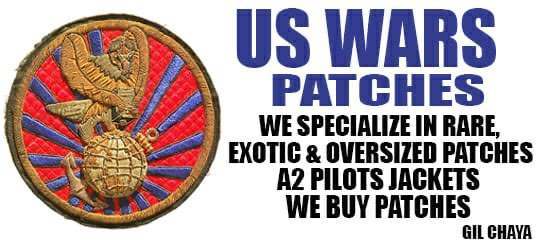
-
* While this forum is partially supported by our advertisers, we make no claim nor endorsement of authenticity of the products which these advertisers sell. If you have an issue with any advertiser, please take it up with them and not with the owner or staff of this forum.




